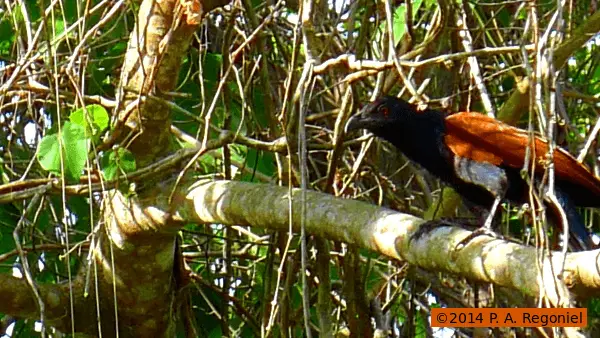What is the role of a bird such as the greater coucal, a species of cuckoo, in the forest ecosystem? How will removal of its forest habitat compromise the other components of the ecosystem? This article explains how displacement and possible extinction of a bird species can impact on their habitat as well as human society.
Barry Commoner’s first Law of Ecology in his book The Closing Circle states that everything is connected to everything else. What affects one organism affects all.
If applied at ecosystem level, this means that the ecosystem’s integrity and resilience is compromised if one or more of the component parts is lost. Whatever animal or plant you find in an ecosystem will have some special role, function or influence on the other components in that ecosystem. The ecosystem works like a clock, where removal of one apparently insignificant part may prevent it from working properly or diminish the clock’s features or function.
This ecosystem principle made me ponder about the fate of the Palawan greater coucal, a bird associated with many omens in other places, that frequent the remnant forest found at the back of our house.
I took a picture of the bird this morning and feature it below. It looks as if it has just awakened from sleep as it sluggishly clambers on a branch of a tree. It cannot sustain flight just like the other birds.

Since the land that we now occupy is classified as commercial land, in due time, the forested lot will be gone. These birds will no longer have their special place to roost and food to feed on once the remaining patches of trees that bear fruit and sustain them are cut down to make way for housing.
Do the greater coucals and other birds matter at all? What will probably happen once they are gone?
To find out how removal of the remaining forest will impact on the bird’s population, if indeed they still exist in great numbers, I will enumerate three roles that these wild birds play in the ecosystem.
Three Roles of the Greater Coucal
The greater coucal plays an important role in the ecosystem within which they live and reproduce. They serve many purposes among which are the following specific roles:
1. Seed dispersants
The greater coucals, just like the other birds, disperse the seeds of plants from fruits that they feed on. Their feeding behavior allows the distribution of plant species across a range of habitat. As a result, the plants have a greater chance to propagate their kind.
2. Aid in nutrient cycling
As the greater coucals move or fly with effort from one place to another, the birds are able to transfer nutrients that they bring with them, i. e., in their bodies. These are nutrients derived from their food. After absorbing the necessary food elements for their metabolic needs, the birds dispose of their organic waste somewhere. Their manure serves as fertilizer to plants thus starting off once again the circulation of nutrients.
Once these birds die, dead organic matter is acted upon by the decomposers. Organic matter is broken down into humus, consisting of minerals and other compounds that are available for plant use. Thus, with the aid of birds, poor nutrient areas are enriched.
3. Pest control
The greater coucals also feed on insects and even snails. Such feeding behavior help control their prey which in large numbers become pests. Economic problems can arise due to a lack of natural predator to prevent its propagation in large numbers (see the case of the mango pulp weevil).
This list enumerates at best a limited description of the role of the greater coucal in the ecosystem. A deeper investigation into its biology and behavior may uncover something that we cannot afford to lose.
What if these birds have genes that can cure an incurable illness? We will never know if we drive them out into extinction.
References
Natarajan,V (1993). Food and feeding habits of the Southern Crow-Pheasant Centropus sinensis parroti Stresemann (Aves : Cuculidae) at Pt. Calimere, Tamil Nadu. J. Bombay Nat. Hist. Soc. 90 (1): 11–16.
Payne, RB (2005). The Cuckoos. Oxford University Press. pp. 238–242. ISBN 0-19-850213-3.
© 2014 June 3 P. A. Regoniel

It’s really a cool and helpful piece of info.
I am satisfied that you shared this useful information with us.
Please stay uss informed like this. Thank you forr sharing.